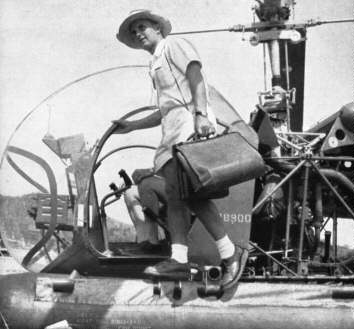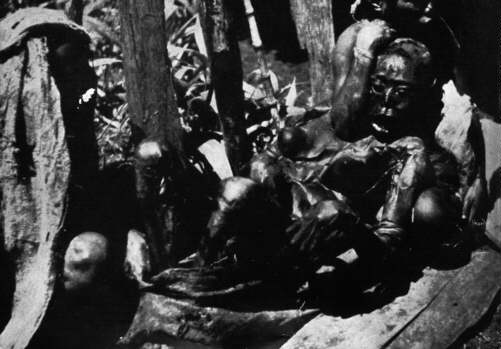
|
|
| Cannibal Culture | |
|
Selected excerpts from Jens Bjerre’s The Last Cannibals on primitive beliefs and customs New Guinea |
Cannibal Courtship and Customs (6)
The religious life of the Kumans is dominated by ancestor worship. They believe in a life after death, where the spirits of the dead live on, and retain the power to interfere with the living. They see how, in the course of nature, plants, animals and human beings come to life, grow to maturity and disappear again. Death is a transformation, not an extinction. When someone dies, the personal spirit, the Kuia, of that individual survives, and indeed for a considerable time remains near the grave of the departed. When a man dreams, it is because his Kuia has temporarily left his body and gone to visit the places the man dreams about. The belief that the dead continue their existence in another form is exemplified in the funeral rites of the Kumans. Immediately after a man has died, the corpse, daubed with grease and decorated with shells, is put on a rough bier and exposed in the village square. The relatives, smeared in mud and clay, sit by the body holding its hands and feet and howling and lamenting loudly to convince the dead man’s Kuia that they grieve for his departure. The women mourners, especially, show no restraint in their mourning; they beat themselves with stones until the blood flows, cut off their ear lobes and break their fingers. The mother of a dead child will go so far as attempting to drown or hang herself. A mourning rite sometimes precipitates a bloody quarrel. If, for instance, a young married woman dies in childbirth, her relatives arriving for the funeral may be so overcome by grief and fury as to attack the husband and his relatives for allowing a member of their family to die.

The mourning rites generally occupy two or three days, even though the body is buried the first day. The corpse is put into the family grave, outside the village, in a sitting posture, with the legs drawn up. All but the face is covered in leaves and on top of the grave are placed sticks, leaves and pieces of bark covered by a thin layer of soil. Some Kumans even put flowers on the grave, not a usual practice among primitive people. If the dead person is a child, a boy, for instance, who has just been initiated, his family keep him sometimes for months before burying him. Even then they place the corpse in an open grave or in a hollow tree-trunk so that the corpse can still be seen, and not until the flesh is rotten do they bury the skeleton completely. The actual funeral itself is conducted by the male relatives who, when it is over, throw water over themselves and leap through an open fire so as to free themselves of contamination by the lurking spirits. For a long time after the funeral, the Kuia will hover around, not only by the grave, but also near the family’s house. The buzz of an insect near the grave, or the sound of a rat or lizard scuttling in the hut during the night, may be signs from the dead. After a time a man’s Kuia will hide in a lake or water-hole, whereas a woman’s will slip down a rat-hole into the ground. But the Kuia keeps on returning to guard the family, to watch that traditions and rules are strictly kept, to punish the wrongdoer and reward the good. Its influence exceeds that of the living, for it can see all. A Kuia can even revenge itself on someone who has injured it in life.

Thus did the lives and customs and beliefs of the Kumans unfold themselves to me like a misty landscape. Through the long and difficult talks I had with old men and women in their dark huts, often while the rain poured monotonously down, the mist lifted, bit by bit, and the details began to reveal themselves. I almost began to visualize the spirits myself, and to feel them hovering around me when, after a whole day’s conversation, I returned late at night to my own hut. It was difficult at times to endure the incessant rain, the vermin and the squalor as I tried to make the interpreter’s language into a coherent pattern, yet it was with regret that I finally said goodbye to the Kumans, to fly back to the coast again.
Jens Bjerre, The Last Cannibals, Michael Joseph, 1956 pp. 142-144